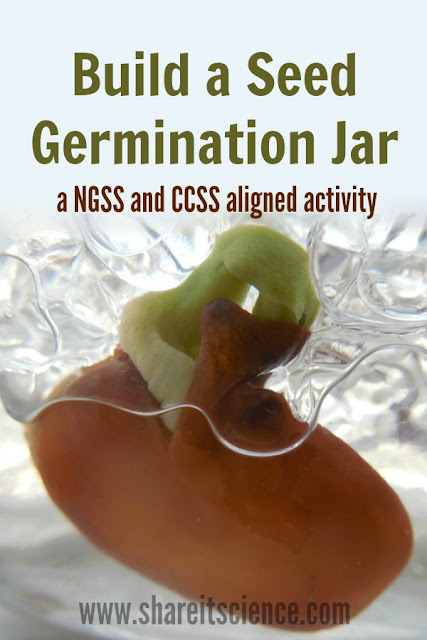Building the germination jar is easy, and it is the perfect addition to your plant unit at school or in your home-school. This inquiry-based science activity is linked to K-2 Next Generation Science Standards and offers an extension idea to align with Common Core English and Language Arts standards as well. Paired with a wonderful children's book, you'll definitely want to add this to your spring to-do list for school or home!
This post contains affiliate links, meaning I will receive a small commission (at no additional cost to you) if you make a purchase after clicking a product link. Please see disclosures page for more details.
Growing "One Bean"
There are so many science lessons and life lessons learned when children grow something themselves. You can make this activity a part of a science unit on life cycles or just an introduction to gardening with children.
First, we read One Bean, a sweet picture book by Anne Rockwell. In this story a boy plants a bean seed and watches it grow. Although told in a narrative style, anyone could follow the process of growing a bean seed themselves along with the story.
The boy puts the bean in a damp paper towel to prepare it for planting. Once it is wrinkled, he plants it in some soil and waits for his seed to sprout. This is where most planting projects become mysterious! The beauty of your germination jar is that you'll be able to watch the process unfold.
Build a Germination Jar
To build your seed viewer, or germination jar, you'll only need a few supplies:
- clear smooth-sided glass or jar
- seeds (we had great success with fava beans!)
- clear water beads
- water
There are many ways to germinate a seed by keeping it moist, including wrapping in a damp paper towel like in the bean story we read. However, I like that by using the water beads, you do not have to cover the top of the jar up with plastic wrap or something else to hold the moisture in. I have used that method many times to teach children about plants. It works, but it can also lead to mold growing because it sometimes stays too wet.
You will have to experiment with how many water beads and how much water to use. The jar we began with ended up being far too large, so eventually we moved our experiment to a smaller glass. Start by using just a few water beads- a tablespoon of them can go a long way. Pour a bit of water on and let them absorb it for a couple of hours before adding anything else.
You want your jar to be moist, but not too wet. You will need enough water beads to hold your seed in place, but not so many that there is no room to grow. This is the experiment within the experiment!
Watch a Seed Germinate
Before you start, soak your bean seed(s) in a glass of water over night. This really helps to get them off to a quick start. We chose fava beans because they are easy for small hands to hold and are large so you can really see what is going on with them.
Once you've soaked your seed and prepared your water beads, place the bean seed so that it is close to the side of the glass and easy to view. Be sure that there are water beads over the top of the seed so that it stays moist.
Then, you wait! Until the seed begins to germinate, you might want to give the jar a little more water each day, carefully pouring it around the outside of the jar where the seeds are. Within a day or so, you should begin to see that first part of the sprout, the radicle, emerging from the seed.
Keep an eye on your jar. If your water beads seem to be shrinking, add just a bit more water. Once you have a green sprout, you can choose whether to leave the seed in the water beads, or plant it in some soil. If you plan on trying to keep your plant growing to maturity, I'd suggest planting it before too long.
If you are lucky enough to have garden space, then that is the obvious place to grow your beans, but for those with space at a premium, particularly schools, I would suggest investigating growing a pocket garden on a wall. Here is one example of a pocket planter.
Meet Common Core and Next Generation Science Standards
This seed investigation will work towards meeting these Next Generation Science Standards for K-2.
NGSS K-LS1-1
NGSS K-ESS3-1
NGSS 2-LS4-1
You can also work towards these K-2 Common Core English and Language Arts Standards by creating an observation journal that includes words as well as drawings.
CCSS.ELA-Literacy.W.K.3
CCSS.ELA-Literacy.W.1.3
CCSS.ELA-Literacy.W.2.3
More Plant Science Investigations!
Learning with plants can continue throughout the spring and summer seasons. It is a great way to investigate biology concepts like pollination with elementary students.
One of my favorite experimental plant projects is growing an avocado plant from its pit.
Try growing a themed garden with kids. Some theme ideas are: an alphabet garden, a rainbow garden, a taco garden, or a pizza garden, or a garden friends companion garden.
Explore math and science with sunflowers, and learn the parts of the flower with students in preschool all the way through High School by doing a flower dissection.
Storybook Science Series
This activity is part of the Storybook Science series. You can find more great book-linked science activities in this series on the Inspiration Laboratories blog.
You'll also want to visit my Storybook Science posts from past years:
- The Dandelion Seed: Design a Seed Engineering Challenge
- "Here Comes the Garbage Barge" Inspired Landfill Model







